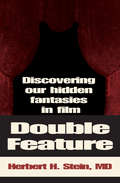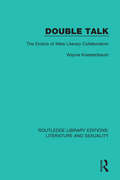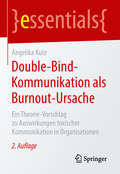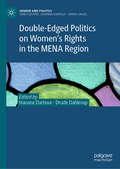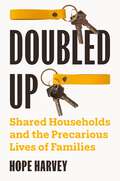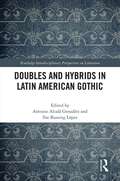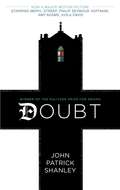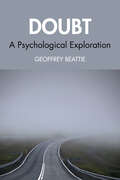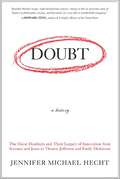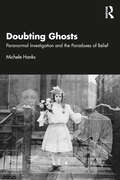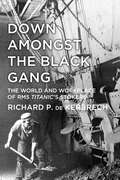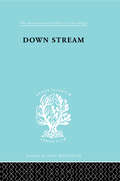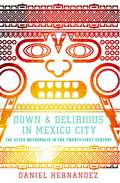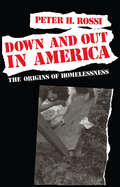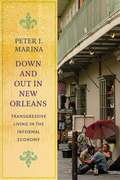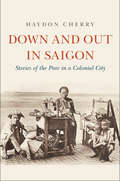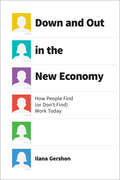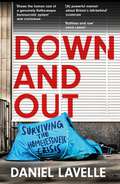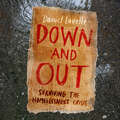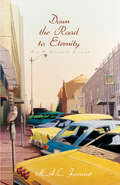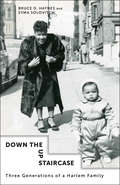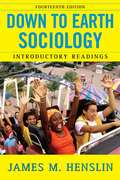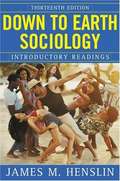- Table View
- List View
Double Feature: Discovering Our Hidden Fantasies in Film
by Herbert H. Steina) What recent smash hit movie secretly depicted fear of the female breast? b) Name some recent films that were preoccupied with castration anxiety? c) Would you be surprised to know that reliving our childhood Oedipal fixations helps us to better understand adult-themed films? You'll find the answers to these and many similarly intriguing questions in DOUBLE FEATURE: DISCOVERING OUR HIDDEN FANTASIES IN FILM by Herbert Stein, M.D. Dr. Stein, a highly-respected Freudian psychiatrist and passionate moviegoer, literally puts our favorite films on the couch and shares his confidential findings with us. In a book that could become a cult classic, he lays bare the truth about unconscious and subconscious themes running through popular culture with fresh, jolting, and often moving insights into some of the most popular films ever made, including JURASSIC PARK, FIELD OF DREAMS, FORRST GUMP, THE SIXTH SENSE, and THE USUAL SUSPECTS. However perceptive we may think ourselves, this book reveals how we unconsciously respond to deeply-embedded archetypal themes in movies and enables us to re-experience films we love in a completely fresh way. Indeed, DOUBLE FEATURE makes our favorite films even more resonant and enables us to articulate even more deeply what it is we love about them.
Double Talk: The Erotics of Male Literary Collaboration (Routledge Library Editions: Literature and Sexuality #1)
by Wayne KoestenbaumSigmund Freud and Josef Breuer on hysteria, J.A. Symonds and Havelock Ellis on sexuality, a novel by Ford Madox Ford and Joseph Conrad, The Waste Land of T.S. Eliot (and Ezra Pound), even the Lyrical Ballads of Wordsworth and Coleridge: men making books together. Wayne Koestenbaum's startling interpretation of literary collaboration focuses on homosexual desire: men write together, he argues, in order either to express or to evade homosexual feelings. Their writing becomes a textual intercourse, the book at once a female body they can share and the child of their partnership. These man-made texts steal a generative power that women's bodies seem to represent. Seen as the site of a struggle between homosexual and homophobic energies, the texts Koestenbaum explores – works of psychoanalysis, sexology, fiction, and poetry – emerge as more complex, more revealing. They crystallize and refract the anxiety of male sexuality at the end of the last century, and open up a deeper understanding of connections today between the erotic and the literary. Drawing upon the work of feminist critics, Koestenbaum connects male collaboration and the exchange of women within patriarchy: he peers into both medical texts and imaginative literature, disturbing our ready acceptance of the co-authored work. This strong and unsettling book transforms our understanding of the creative process, providing a new sense of what both collaborative and solitary artistry mean.
Double-Bind-Kommunikation als Burnout-Ursache: Ein Theorie-Vorschlag zu Auswirkungen toxischer Kommunikation in Organisationen (essentials)
by Angelika KutzIn diesem essential untersucht Angelika Kutz, wie sich paradoxe Double-Bind-Kommunikation auf Mitarbeiter und Organisationen auswirkt. Ziel ist es, die Selbstwert-Vernichtungsmaschinerie und krankheitsfördernde Wirkung des toxischen Kommunikationsmusters Double Bind transparent zu machen. Aus den Untersuchungsergebnissen leitet die Autorin folgende Fragen ab: Sind Burnout und Organizational Burnout in Wahrheit eine Double-Bind-induzierte Arbeitsbindungs- und Arbeitsbeziehungsstörung? Heizt Double Bind und die darauf basierende Beziehungsstörung den zunehmenden Werteverlust und damit die Selbstzerstörung der globalen Double-Bind-Gesellschaft an?
Double-Edged Politics on Women’s Rights in the MENA Region (Gender and Politics)
by Hanane Darhour Drude DahlerupWhile the Arab Uprisings presented new opportunities for the empowerment of women, the sidelining of women remains a constant risk in the post-revolutionist MENA countries. Changes in the position of women are crucial to the reconfiguration of state-society relations and to the discussions between Islamist and secular trends. Theoretically framed and based on new empirical data, this edited volume explores women’s activism and political representation as well as discursive changes, with a particular focus on secular and Islamic feminism, and changes in popular opinions on women’s position in society. While the contributors express optimistic as well as more pessimistic views for the future, they agree that this is a period of uncertainty for women in the region, and that support by ruling elites towards women’s rights remains ambiguous and double-edged.
Doubled Up: Shared Households and the Precarious Lives of Families
by Hope HarveyHow sharing a home with extended family or friends serves as a crucial, but imperfect, private safety net for families with childrenMore than fifteen percent of US children—over eleven million—live in doubled-up households, sharing space with extended family or friends. These households are even more common among low-income families, families of color, and single-parent families, functioning as a private safety net for many in a country with extremely limited public support for families. Yet despite their prevalence, we know little about how shared households form and how they shape family life. Doubled Up is an in-depth look at the experiences of families with children living in doubled-up households.Drawing on extensive interviews with sixty parents living in doubled-up households, Hope Harvey examines what circumstances and motivations lead families to form doubled-up households, how living in shared households affects daily routines, and how families fare after these arrangements dissolve.Harvey shows that although families rely on doubling up to get by in the face of rapidly rising housing costs, precarious labor markets, and unaffordable childcare, these private arrangements are rarely sufficient to overcome such structural barriers. And doubling up incurs its own costs for both host and guest families. For doubled-up families, negotiating household relationships and navigating shared space reshapes family life. Understanding the dynamics of doubled-up households extends scholarship on family life beyond the nuclear family and points the way toward better policies that will serve all families.
Doubles and Hybrids in Latin American Gothic (Routledge Interdisciplinary Perspectives on Literature)
by Antonio Alcalá González Ilse Bussing LópezDoubles and Hybrids in Latin American Gothic focuses on a recurrent motif that is fundamental in the Gothic—the double. This volume explores how this ancient notion acquires tremendous force in a region, Latin America, which is itself defined by duplicity (indigenous/European, autochthonous religions/Catholic). Despite this duplicity and at the same time because of it, this region has also generated "mestizaje," or forms resulting from racial mixing and hybridity. This collection, then, aims to contribute to the current discussion about the Gothic in Latin America by examining the doubles and hybrid forms that result from the violent yet culturally fertile process of colonization that took place in the area.
Doubt (movie tie-in edition)
by John Patrick ShanleyNow a major motion picture! Starring Meryl Streep, Philip Seymour Hoffman, and Amy Adams. Written and directed by John Patrick Shanley from his Pulitzer Prize-winning play."The best new play of the season. That rarity of rarities, an issue-driven play that is unpreachy, thought-provoking, and so full of high drama that the audience with which I saw it gasped out loud a half-dozen times at its startling twists and turns. Mr. Shanley deserves the highest possible praise: he doesn't try to talk you into doing anything but thinking-hard-about the gnarly complexity of human behavior."--Terry Teachout, The Wall Street Journal"A breathtaking work of immense proportion. Positively brilliant."--Melissa Rose Bernardo, Entertainment Weekly"#1 show of the year. How splendid it feels to be trusted with such passionate, exquisite ambiguity unlike anything we have seen from this prolific playwright so far. In just ninety fast-moving minutes, Shanley creates four blazingly individual people. Doubt is a lean, potent drama . . . passionate, exquisite, important and engrossing."--Linda Winer, NewsdayJohn Patrick Shanley is the author of numerous plays, including Danny in the Deep Blue Sea, Dirty Story, Four Dogs and a Bone, Psychopathia, Sexualis, Sailor's Song, Savage in Limbo, and Where's My Money? He has written extensively for TV and film, and his credits include the teleplay for Live from Baghdad and screenplays for Congo; Alive; Five Corners; Joe Versus the Volcano, which he also directed; and Moonstruck, for which he won an Academy Award for best original screenplay.
Doubt: A Psychological Exploration
by Geoffrey BeattieBlending the latest academic research with case studies of famous figures, this highly insightful book presents ‘doubt’ as a central concept for psychology. It is a concept which has been oddly neglected in the past, despite its ubiquitous nature and far-reaching influence. Exploring everything from self-doubt and impostor syndrome to the weaponisation of doubt with respect to climate change and the marketing of cigarettes, bestselling author Geoffrey Beattie navigates readers through the various ways doubt can start and develop, changing the individual in the process. Written in Beattie’s distinctive and engaging style, Doubt takes the reader into the lives of transformational thinkers, artists, scientists and writers to explore how and why doubt was crucial in their lives and how the likes of Kafka, Jung, Picasso and Turing succumbed to doubt or learned to control it. Beattie argues that doubt is central to the self; it can be either a safeguarding mechanism or a distraction, rational or irrational, systematic or random, healthy or pathological, productive or non-productive. The book helps readers to recognise how doubt may have been operating in their own lives and to identify how and when it has been used against us – for example, to prevent climate action – and at what personal and societal cost. Presenting a compelling case for why doubt cannot be ignored, this book is of major interest to academics from a wide range of disciplines, including social and cognitive psychology, clinical and counselling psychology, sport psychology, sociology, business studies, politics, art and literature, as well as the general public, who may well see something of themselves in its pages.
Doubt: The Great Doubters and Their Legacy of Innovation from Socrates and Jesus to Thomas Jefferson and Emily Dickinson
by Jennifer Michael HechtIn the tradition of grand sweeping histories such as From Dawn To Decadence, The Structure of Scientific Revolutions, and A History of God, Hecht champions doubt and questioning as one of the great and noble, if unheralded, intellectual traditions that distinguish the Western mind especially-from Socrates to Galileo and Darwin to Wittgenstein and Hawking. This is an account of the world's greatest ‘intellectual virtuosos,' who are also humanity's greatest doubters and disbelievers, from the ancient Greek philosophers, Jesus, and the Eastern religions, to modern secular equivalents Marx, Freud and Darwin—and their attempts to reconcile the seeming meaninglessness of the universe with the human need for meaning,This remarkable book ranges from the early Greeks, Hebrew figures such as Job and Ecclesiastes, Eastern critical wisdom, Roman stoicism, Jesus as a man of doubt, Gnosticism and Christian mystics, medieval Islamic, Jewish and Christian skeptics, secularism, the rise of science, modern and contemporary critical thinkers such as Schopenhauer, Darwin, Marx, Freud, Nietzsche, the existentialists.
Doubting Ghosts: Paranormal Investigation and the Paradoxes of Belief
by Michele HanksBased on ethnographic research in England, Doubting Ghosts explores the paradoxes faced by paranormal investigators or "ghost hunters": in spite of spending significant time observing and documenting what they suspect to be paranormal phenomena—in a scientific, secular and rational fashion—many paranormal investigators remain skeptical about the existence of the paranormal. What, then, does it mean to regularly see ghosts and yet to not believe ghosts are real?Examining the manner in which the scientific approach adopted by investigators produces profound doubts about the existence of the paranormal, the meaning of science, and the nature of modernity, the author demonstrates that doubt itself is central to experiences of secularity and that doubt can constitute a foundation for long-term engagements with the paranormal. Thus, paranormal investigators are able to sustain a relationship, albeit an uneasy one, with the paranormal while maintaining a commitment to a scientific, secular, and rational worldview.A contribution to understandings of doubt, science, religion, and disenchantment, this book will appeal to scholars of sociology and anthropology.
Down Amongst the Black Gang: The World and Workplace of RMS Titanic's Stokers
by Richard P. KerbrechDown in the fiery belly of the luxury liner RMS Titanic, a world away from the first-class dining rooms and sedate tours of the deck, toiled the ‘black gang’. Their work was gruelling and hot, and here de Kerbrech introduces the reader to the dimly lit world and workplace of Titanic’s stokers. Beginning with a journey around some of the major elements of machinery that one might encounter in the giant ship’s engine and boiler rooms, those with a technical mind would be sated, while the accessible style would aid the lay reader in this more specialist title. The human side of working for the most famous liner is also involved in an exploration of stokers’ duties, environment and conditions: what it was like to be one of the ‘black gang’.
Down Stream Ils 216: Failure in the Grammar School (International Library of Sociology)
by R. R. Dale S. GriffithFirst Published in 1998. Routledge is an imprint of Taylor & Francis, an informa company.
Down and Delirious in Mexico City
by Daniel HernandezMEXICO CITY, with some 20 million inhabitants, is the largest city in the Western Hemisphere. Enormous growth, raging crime, and tumultuous politics have also made it one of the most feared and misunderstood. Yet in the past decade, the city has become a hot spot for international business, fashion, and art, and a magnet for thrill-seeking expats from around the world. In 2002, Daniel Hernandez traveled to Mexico City, searching for his cultural roots. He encountered a city both chaotic and intoxicating, both underdeveloped and hypermodern. In 2007, after quitting a job, he moved back. With vivid, intimate storytelling, Hernandez visits slums populated by ex-punks; glittering, drug-fueled fashion parties; and pseudo-native rituals catering to new-age Mexicans. He takes readers into the world of youth subcultures, in a city where punk and emo stand for a whole way of life--and sometimes lead to rumbles on the streets. Surrounded by volcanoes, earthquake-prone, and shrouded in smog, the city that Hernandez lovingly chronicles is a place of astounding manifestations of danger, desire, humor, and beauty, a surreal landscape of "cosmic violence." For those who care about one of the most electrifying cities on the planet, "Down & Delirious in Mexico City is essential reading" (David Lida, author of First Stop in the New World).
Down and Out in America: The Origins of Homelessness
by Peter H. RossiThe most accurate and comprehensive picture of homelessness to date, this study offers a powerful explanation of its causes, proposes short- and long-term solutions, and documents the striking contrasts between the homeless of the 1950s and 1960s and the contemporary homeless population, which is younger and contains more women, children, and blacks.
Down and Out in America: The Origins of Homelessness
by Peter H. RossiThe most accurate and comprehensive picture of homelessness to date, this study offers a powerful explanation of its causes, proposes short- and long-term solutions, and documents the striking contrasts between the homeless of the 1950s and 1960s and the contemporary homeless population, which is younger and contains more women, children, and blacks.
Down and Out in New Orleans: Transgressive Living in the Informal Economy (Studies in Transgression)
by Peter J. MarinaIn the years since Hurricane Katrina, the modern-day bohemians of New Orleans have found themselves forced to the edges of poverty by the new tourist economy. Modeling his work after George Orwell’s Down and Out in Paris and London, the sociologist and ethnographer Peter J. Marina explores this unfamiliar side of the gentrifying “new” New Orleans. In 1920s Paris, Orwell witnessed an influx of locals and outsiders seeking authenticity while struggling to live with bourgeois society. Marina finds a similar ambivalence in New Orleans: a tourism-dependent city whose commerce caters largely to well-heeled natives and upper-class travelers, where many creative locals and wanderers have remained outsiders, willingly or otherwise. Marina does not merely interview these spirited urban misfits—he lives among them. Down and Out in New Orleans follows their journeys, depicting the lives of those on the social fringes of a resilient city. Marina finds work as a bartender, street mime, and poet. Along the way, he visits homeless shelters, squats in abandoned buildings, attends rituals in cemeteries, and befriends writers, musicians, occultists, and artists as they look for creative solutions to the contradictory demands of late capitalism. Marina does for New Orleans what Orwell did for Paris a century earlier, providing a rigorous, unrelenting, and original glimpse into the subcultures of a city in rapid change.
Down and Out in Saigon: Stories of the Poor in a Colonial City
by Haydon CherryA moving portrait of the lives of six poor city-dwellers, set in early twentieth century colonial Saigon Historian Haydon Cherry offers the first comprehensive social history of the urban poor of colonial French Saigon by following the lives of six individuals—a prostitute, a Chinese laborer, a rickshaw puller, an orphan, an incurable invalid, and a destitute Frenchman—and how they navigated the ups and downs of the regional rice trade and the institutions of French colonial rule in the first half of the twentieth century. “Down and Out in Saigon is marked by three qualities that endow it with unusual value: the originality of its subject matter, as the first and only history of colonial Saigon’s poor population, the excellence of its research, and Cherry’s elegant prose.”—Peter B. Zinoman, University of California, Berkeley “This is more than a corrective of revolutionary historiography—it is a tour de force that brings marginal and forgotten lives into the story of modern Vietnamese history.”—Charles Keith, author of Catholic Vietnam: A Church from Empire to Nation
Down and Out in the New Economy: How People Find (or Don’t Find) Work Today
by Ilana GershonFinding a job used to be simple. You’d show up at an office and ask for an application. A friend would mention a job in their department. Or you’d see an ad in a newspaper and send in your cover letter. Maybe you’d call the company a week later to check in, but the basic approach was easy. And once you got a job, you would stay—often for decades. Now . . . well, it’s complicated. If you want to have a shot at a good job, you need to have a robust profile on LinkdIn. And an enticing personal brand. Or something like that—contemporary how-to books tend to offer contradictory advice. But they agree on one thing: in today’s economy, you can’t just be an employee looking to get hired—you have to market yourself as a business, one that can help another business achieve its goals. That’s a radical transformation in how we think about work and employment, says Ilana Gershon. And with Down and Out in the New Economy, she digs deep into that change and what it means, not just for job seekers, but for businesses and our very culture. In telling her story, Gershon covers all parts of the employment spectrum: she interviews hiring managers about how they assess candidates; attends personal branding seminars; talks with managers at companies around the United States to suss out regional differences—like how Silicon Valley firms look askance at the lengthier employment tenures of applicants from the Midwest. And she finds that not everything has changed: though the technological trappings may be glitzier, in a lot of cases, who you know remains more important than what you know. Throughout, Gershon keeps her eye on bigger questions, interested not in what lessons job-seekers can take—though there are plenty of those here—but on what it means to consider yourself a business. What does that blurring of personal and vocational lives do to our sense of our selves, the economy, our communities? Though it’s often dressed up in the language of liberation, is this approach actually disempowering workers at the expense of corporations? Rich in the voices of people deeply involved with all parts of the employment process, Down and Out in the New Economy offers a snapshot of the quest for work today—and a pointed analysis of its larger meaning.
Down and Out: Surviving the Homelessness Crisis
by Daniel Lavelle'Lavelle's ruthless and raw exposé fills me with rage, but also with hope - underneath this harrowing story of injustice lies a lyrical longing for a more compassionate and caring future' DAVID LAMMYAt once a powerful memoir, unflinching polemic and probing investigation into modern homelessness in the UK, by award-winning investigative journalist Daniel LavelleDaniel Lavelle left care at the age of nineteen, and experienced homelessness for the first time not long after. So began a life spent navigating social services that were not fit for purpose, leaving Daniel and many like him slipping through the cracks.In Down and Out, Daniel draws on his own experiences - as well as those of the witty, complex, hopeful individuals he has encountered who have been shunned or forgotten by the state that is supposed to provide for them - in order to shine a powerful light on this dire situation. Down and Out is a true state-of-the-nation examination of modern homelessness: assessing its significance, its precursors and causes, as well as the role played by government, austerity, charities, and other systems in perpetuating this crisis. Ultimately, it seeks to ask how we as a society might change our practices and attitudes so that, one day, we can bring this injustice to an end.More praise for Down and Out:'Lavelle is a vital voice on one of the most pressing scandals facing Britain today. A book for every politician, policy maker and reader who wants a fairer and kinder country' FRANCES RYAN, author of CRIPPLED
Down and Out: Surviving the Homelessness Crisis
by Daniel Lavelle'Lavelle's ruthless and raw exposé fills me with rage, but also with hope - underneath this harrowing story of injustice lies a lyrical longing for a more compassionate and caring future' DAVID LAMMYAt once a powerful memoir, unflinching polemic and probing investigation into modern homelessness in the UK, by award-winning investigative journalist Daniel LavelleDaniel Lavelle left care at the age of nineteen, and experienced homelessness for the first time not long after. So began a life spent navigating social services that were not fit for purpose, leaving Daniel and many like him slipping through the cracks.In Down and Out, Daniel draws on his own experiences - as well as those of the witty, complex, hopeful individuals he has encountered who have been shunned or forgotten by the state that is supposed to provide for them - in order to shine a powerful light on this dire situation. Down and Out is a true state-of-the-nation examination of modern homelessness: assessing its significance, its precursors and causes, as well as the role played by government, austerity, charities, and other systems in perpetuating this crisis. Ultimately, it seeks to ask how we as a society might change our practices and attitudes so that, one day, we can bring this injustice to an end.More praise for Down and Out:'Lavelle is a vital voice on one of the most pressing scandals facing Britain today. A book for every politician, policy maker and reader who wants a fairer and kinder country' FRANCES RYAN, author of CRIPPLED
Down and Out: Surviving the Homelessness Crisis
by Daniel Lavelle'When I zipped up my tent on that first night sleeping rough, I felt no despair... I was just another care leaver who had lost control of his life.'As a care-leaver who has experienced homelessness, award-winning investigative journalist Daniel Lavelle has spent his life navigating social services that are not fit for purpose and leave many vulnerable people slipping through the cracks. For though the right to adequate housing is enshrined in the Universal Declaration of Human Rights, the reality is another, much grimmer, story.In Down and Out, Daniel draws on his own experiences, as well as those of the witty, complex, hopeful individuals he has encountered who have been shunned or forgotten by the state that is supposed to provide for them, in order to shine a powerful light on this world. Down and Out is a true state-of-the-nation examination of modern homelessness, assessing its significance, its precursors and causes, as well as the role played by government, austerity, charities, and other systems in perpetuating this crisis. Ultimately, it seeks to ask how we as a society might change our practices and attitudes so that one day we might bring it to an end.(P) 2022 Headline Publishing Group Ltd
Down the Road to Eternity
by Marion FarrantDown the Road to Eternity: New & Selected Fiction is a collection of M.A.C. Farrant's work dating from 1985 to 2009, including the complete suite of eighteen stories, The North Pole, in which our individual existences are bludgeoned by the threat of "end times"-climate change, species extinction, pandemics, and really bad politics.
Down the Up Staircase: Three Generations of a Harlem Family
by Bruce Haynes Syma SolovitchDown the Up Staircase tells the story of one Harlem family across three generations, connecting its journey to the historical and social forces that transformed Harlem over the past century. Bruce D. Haynes and Syma Solovitch capture the tides of change that pushed blacks forward through the twentieth century—the Great Migration, the Harlem Renaissance, the early civil rights victories, the Black Power and Black Arts movements—as well as the many forces that ravaged black communities, including Haynes's own. As an authority on race and urban communities, Haynes brings unique sociological insights to the American mobility saga and the tenuous nature of status and success among the black middle class.In many ways, Haynes's family defied the odds. All four great-grandparents on his father's side owned land in the South as early as 1880. His grandfather, George Edmund Haynes, was the founder of the National Urban League and a protégé of eminent black sociologist W. E. B. Du Bois; his grandmother, Elizabeth Ross Haynes, was a noted children's author of the Harlem Renaissance and a prominent social scientist. Yet these early advances and gains provided little anchor to the succeeding generations. This story is told against the backdrop of a crumbling three-story brownstone in Sugar Hill that once hosted Harlem Renaissance elites and later became an embodiment of the family's rise and demise. Down the Up Staircase is a stirring portrait of this family, each generation walking a tightrope, one misstep from free fall.
Down to Earth Sociology, 14th Edition
by James M. HenslinFor thirty-five years and through thirteen editions, Jim Henslin's Down to Earth Sociology has opened new windows onto the social realities that shape our world. Now in its fourteenth edition, the most popular anthology in sociology includes new articles on our changing world while also retaining its classic must-read essays. Focusing on social interaction in everyday life, the forty-six selections bring students face-to-face with the twin projects of contemporary sociology: understanding the individual's experience of society and analyzing social structure. The fourteenth edition's exceptional new readings include selections on the role of sympathy in everyday life, mistaken perceptions of the American family, the effects of a criminal record on getting a job, and the major social trends affecting our future. Together with these essential new articles, the selections by Peter Berger, Herbert Gans, Erving Goffman, Donna Eder, Zella Luria, C. Wright Mills, Deborah Tannen, Barrie Thorne, Sidney Katz, Philip Zimbardo, and many others provide firsthand reporting that gives students a sense of "being there." Henslin also explains basic methods of social research, providing insight into how sociologists explore the social world. The selections in Down to Earth Sociology highlight the most significant themes of contemporary sociology, ranging from the sociology of gender, power, politics, and religion to the contemporary crises of racial tension, crime, rape, poverty, and homelessness.
Down to Earth Sociology: Introductory Readings (13th edition)
by James M. HenslinThe book includes new articles on our changing world while also retaining its classic ones. Focusing on social interaction in everyday life, the selections bring students face-to-face with contemporary sociology.
